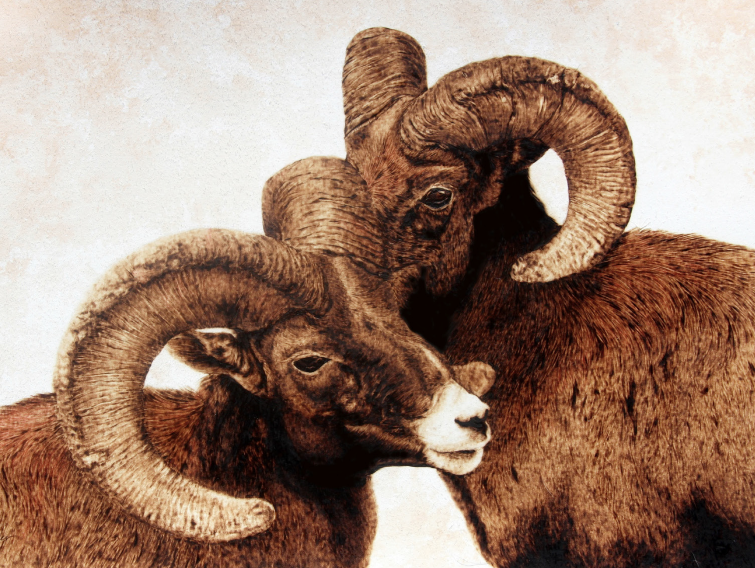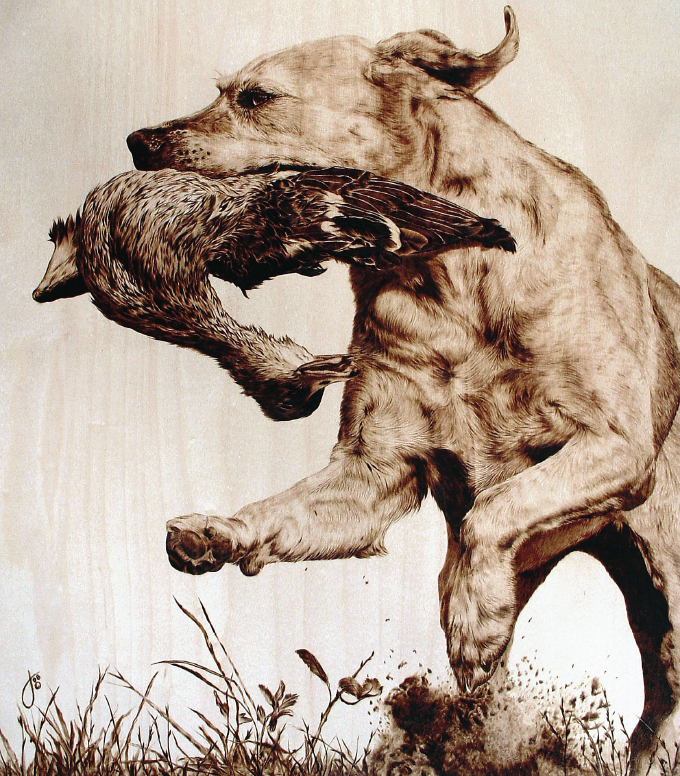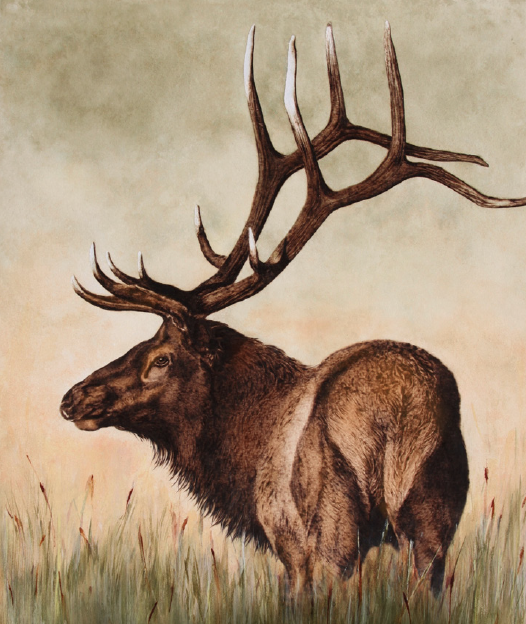Playing with Fire: Pyrography by Julie Bender
July 1, 2020



 SCA Articles
SCA Articles

Julie Bender traces her rise as an acclaimed pyrography artist to her dogs.
We all know that bird dogs lead us mercifully astray. Paying no heed to the numbing daze of beaten paths, their instincts guide us where we need to go; that place is nature’s equivalent of the spiritual lost and found.
Julie Bender has a nose for finding such haunts and it’s not altogether different from that of her beloved living and departed Hungarian Vizslas.
“I owe a lot to my dogs,” she says. “They provide a lot of thrust with what I do and who I am.”
While working for years as a project manager at the National Center for Injury Prevention and Control in Atlanta, Bender credits her dogs, AKC licensed and marvel performers at field trials on quail plantations across the Southeast, with providing an escape.
Yet between the rigors of the office and participating in the sporting dog world, something else, too, delivered solace. Bender’s enigmatic artwork, literally borne of fire ignition pens pressed to wood and paper, stands today as a mile-marker, reminding us how far she’s come through the brambles.
Bender’s primary art medium is pyrography.
“Heat is my substance,” she says. “Hot metal tips and torches are my brushes. Paper and wood are my canvas. Discovering innovative ways to express my artistic vision through burning is my greatest challenge and reward.”
Wood burning, also called pokerwork, is an age-old form. Like paleo-artisans who lifted sticks with charcoal points out of ancient campfires and pressed their tips to the sides of caves to draw their interpretations of wildlife, Bender’s visions are all about visceral responses to the outdoor world.
Her hunting scenes, portrayals of wild animals, cowboy culture, equines and especially dogs are praised for their design. With collectors around the world, her works have won awards at the Stampede Western Invitational Art Show in Greeley, Colorado, the Waterfowl Festival in Easton, Maryland and the Society of Animal Artists. She has been juried into the Leigh Yawkey Woodson Art Museum’s prestigious Birds in Art exhibition, where her art has been acquired for its permanent collection. Her creations seem ever more remarkable when you consider the intricacies of her uncommon medium.

pyrography works on maple wood.
“When I first encountered her work, it struck me as being unique and, over the years, it’s done nothing but get better and more interesting,” says Jack Summers, owner of Lovetts Gallery in Tulsa, Oklahoma.
Summers has dealt in fine art for four decades, representing prominent living painters and sculptors. He says: “It’s rare that pieces cause clients to stand in front them, wondering aloud how the visual illusions are made. Bender’s work does that.”
When Sporting Classics last visited with her in 2012, Bender explained that her first Vizsla had died 10 years prior. The deep impact of losing her prompted Bender to take up wood burning because she wanted to create something personal that would memorialize her four-legged companion and best friend. What she created was a burned portrait of her dog on her urn.
Yet in 2012, something else was stirring in Bender. Restless, she was ready for a change of scenery and technique.
Bender by then had already made a name for herself with pyrography. Her wildlife and sporting scenes were being avidly collected and she was regularly taking bird dog commissions. The St. Louis native who achieved a degree in fine art from the University of Missouri had a strong desire to get out of the Southeast. She left her secure federal job in Atlanta and made a daring leapfrog move across the Mississippi into the West.
Settling in Loveland, Colorado, Bender took up art fulltime. Her home and studio are located just downslope from the breathtaking heights of Rocky Mountain National Park. The location has given her ready access to elk, moose, bighorns, mountain goats, foxes, deer and horses roaming the countryside. She’s also expanded her repertoire to include rodeo athletes and scenes from working ranches.
“Living in the West and making art my career, I’ve been able to burn through the night,” she says only half in gest.
Still, in the competitive art market, pieces in black and white or sepia tone can be difficult to sell. Bender for the last few years has been pushing the aesthetic limits of pyrography to great success.
Within the sporting and wildlife art world are a few people like scratchboard artist Sally Maxwell and graphite artist Cole Johnson who, like Bender, have gained reputations on the strength of their drawing. However, after Maxwell inserted color and was accused of committing sacrilege by scratchboard purists, she didn’t stop because collectors savored her fresh approach.
Bender had similar instincts about pyrography. “I remember when Julie began contemplating whether to add color to her pieces,” Sommers says. “She was extremely reluctant because she didn’t know how well they would be received.”
Bender shouldn’t have worried, because her first piece to include color sold as soon as it appeared on the gallery wall. Although her tinted pieces appear as if they’re awash in watercolor, Bender actually works with an acrylic palette albeit the paint is supplely applied.
Bender always has been praised for her draftsmanship and strong compositions. Her work today is a blend of improvisation and drawing from memory.
“A lot of artists know exactly where every stroke will go and be very deliberate about it. Of course, I have a game plan with every piece, but I can’t map out every line beforehand. It’s no fun.”

Still, she adds, “You need to know what you are doing because once you start in, you are committed. Burning is not a forgiving medium.”
When a piece succeeds, as is often the case with Bender, it is exquisite. In her works Full Throttle and Broncin’ Ballet, Bender communicates the drama of calf roping and riding bucking broncs as if channeling Charlie Russell. In Autumn Rut, a bull elk stands ready to hold his own against rivals. Meanwhile, a classic sporting scene, Method to the Madness, captures birds and pheasants in full flush.
Along with adding color to some works, Bender swapped out wood for paper. Her older compositions, which incorporated wood grain patterns into her designs, have the feel of classic etchings, though the hard surfaces sometimes interfered with effects she wanted to convey. The switch, she notes, involved trial and error.
Her initial paper choices proved to be too thin as her pyrography pens burned straight though. Eventually, she found a heavier stock, which came with the added benefit of being able to hold color and emanate a look of texture.
Bender acknowledges she is, by personality, a perfectionist. Imagery portrayed in traditional pyrography often features tight representations of subject matter to make it vivid. Bender, however, is moving these days in a more exciting and looser direction. She has been careful and circumspect with how she brings color into her work. Not only does she apply acrylic paint to enhance tonal harmony between light and dark areas, she’s even experimenting with coffee, making pyrography a true contemporary 21st century medium.
The impact of Bender’s designs has earned her some interesting commissions. At the elegant new Marriott Hotel in downtown Calgary, her large portrayals of a Texas longhorn calf and a wild horse greet guests moving between the lobby and their rooms.
“Her work over the years has done nothing but get more impactful. She does a good job with composition and comes up with some of the best I’ve seen,” Summers says.
For Bender, any success she’s achieved is a tribute to her dogs who served as her companions, first models, muses, teachers of animal intelligence and catalysts in helping her find a future in art. “My dogs were and are my life and participating in events that surrounded them were my greatest joy,” she says. “What I hold in my heart for them is gratitude. They gave me so much to love on. They helped open my eyes to the beauty of the world.”
